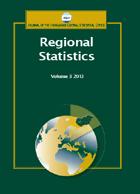The impact of the Trianon Peace Treaty on the border zones – an attempt to analyse the historic territorial development pattern and its changes in Hungary
The impact of the Trianon Peace Treaty on the border zones – an attempt to analyse the historic territorial development pattern and its changes in Hungary
Author(s): János PénzesSubject(s): History, Social Sciences, Economy, Geography, Regional studies
Published by: Központi Statisztikai Hivatal
Keywords: border areas; composite indicator; spatial inequality; spatial pattern; territorial development
Summary/Abstract: The multidimensional approach of territorial development is applied in the research. A composite indicator created for the present situation and named ‘territorial development index’ was adapted to the Hungarian historical data from 1910 on the LAU 2 level. The effects of the Trianon borders were observed on the basis of the comparative analysis of the historical and present development indices.The common methodological basis provided the opportunity to compare the outputs of the computations. Some of the underdeveloped areas along the present state border of Hungary have existed even before the demarcation of the Trianon borders (dominantly along the Eastern-Slovakian border, the Northern part of the Romanian border and along the Slovenian border). Large scale disparities existed at the beginning of the 20th century which decreased significantly by 2016. The general tendency of convergence influenced the border zones as well – both closing up to the Hungarian average and within-region convergence could be measured. Contrary to this, the geographical concentration of the most underdeveloped settlements (the lowest quantiles of the settlement ranking) became visible along the Eastern-Slovakian, the Ukrainian, the Romanian and the Croatian sections of the border zone. The former hinterlands of the large towns along the Hungarian-Romanian border tended to face negative tendencies in their development paths. The settlements in the border zone characteristically stepped forward along the Slovenian, Austrian and Western-Slovakian border sections.The results tended to draw the attention to the spatial polarization process because significant parts of the underdeveloped territories located along the borders did not exist prior to 1920. Furthermore, the increasing concentration of disadvantaged settlements in the border zone was not only the direct effect of the creation of the new state boundary but the cumulative result of multiple disadvantageous ongoing social processes. However, the border– undoubtedly – has had a significant role in the conservation and strengthening of the negative tendencies. At the same time,developed zones – more or less independently of the new borders – became more developed by 2016 (especially along the Western and North-western part of the state border).
Journal: Regional Statistics
- Issue Year: 10/2020
- Issue No: 01
- Page Range: 60-81
- Page Count: 22
- Language: English

